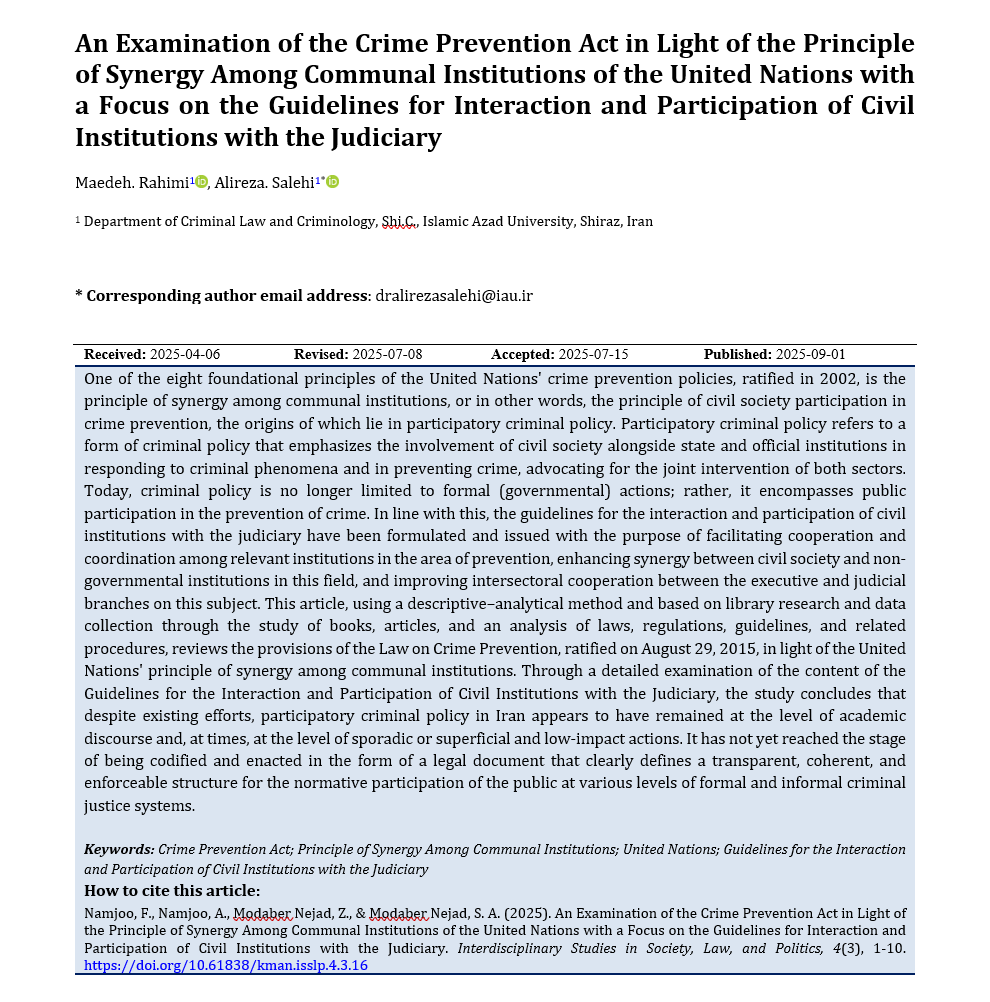An Examination of the Crime Prevention Act in Light of the Principle of Synergy Among Communal Institutions of the United Nations with a Focus on the Guidelines for Interaction and Participation of Civil Institutions with the Judiciary
Keywords:
Crime Prevention Act, Principle of Synergy Among Communal Institutions, United Nations, Guidelines for the Interaction and Participation of Civil Institutions with the JudiciaryAbstract
One of the eight foundational principles of the United Nations' crime prevention policies, ratified in 2002, is the principle of synergy among communal institutions, or in other words, the principle of civil society participation in crime prevention, the origins of which lie in participatory criminal policy. Participatory criminal policy refers to a form of criminal policy that emphasizes the involvement of civil society alongside state and official institutions in responding to criminal phenomena and in preventing crime, advocating for the joint intervention of both sectors. Today, criminal policy is no longer limited to formal (governmental) actions; rather, it encompasses public participation in the prevention of crime. In line with this, the guidelines for the interaction and participation of civil institutions with the judiciary have been formulated and issued with the purpose of facilitating cooperation and coordination among relevant institutions in the area of prevention, enhancing synergy between civil society and non-governmental institutions in this field, and improving intersectoral cooperation between the executive and judicial branches on this subject. This article, using a descriptive–analytical method and based on library research and data collection through the study of books, articles, and an analysis of laws, regulations, guidelines, and related procedures, reviews the provisions of the Law on Crime Prevention, ratified on August 29, 2015, in light of the United Nations' principle of synergy among communal institutions. Through a detailed examination of the content of the Guidelines for the Interaction and Participation of Civil Institutions with the Judiciary, the study concludes that despite existing efforts, participatory criminal policy in Iran appears to have remained at the level of academic discourse and, at times, at the level of sporadic or superficial and low-impact actions. It has not yet reached the stage of being codified and enacted in the form of a legal document that clearly defines a transparent, coherent, and enforceable structure for the normative participation of the public at various levels of formal and informal criminal justice systems.
Downloads
References
Arab, A. A., Khaghani Esfahani, M., & Majidi, S. M. (2021). Essentials of Civil Society Empowerment in Strengthening Iran's Participatory Criminal Policy. Economic Jurisprudence Studies (Special Issue on New Legal and Jurisprudential Topics), 121-139.
Azimian, A., Shamloo, B., Mahdavi Sabet, M. A., & Mehara, N. (2017). Pragmatism of Participatory Criminal Policy toward Violence Against Women. Journal of Private and Criminal Law Research, 13(32), 55-83.
Azimzadeh Ardebili, F., & Hesabi, S. (2011). Criminal Policy and Its Conceptual Evolution. Legal Excellence Journal, 4(15), 113-133.
Ghamami, S. M. M. (2018). A Model for Reviving Public Rights through Transformation in Norms and Judicial Structures. Islamic Law Quarterly, 15(58), 71-92.
Jamshidi, A. (2011). Participatory Criminal Policy. Mizan Publishing.
Koonani, S., Ansari, J., & Mandani, E. (2012). Criminal Policy: From Discourse to Rhizomatic Constructions. Majd Publishing.
Lashni Parsa, R. (2008). Crime Prevention and Control: Challenges and Perspectives. Police Human Development Bimonthly, 5(19), 49-82.
Mirkhalili, S. M. (2008). Situational Crime Prevention with a Look at Islamic Criminal Policy. Institute for Humanities and Islamic Studies Publishing.
Mohebbi, M. T. (2014). Developments in Participatory Criminal Policy. Nou Publishing.
Nobahar, R. (2008). Criminal Law Protection of Public and Private Spheres. Jungle Publications.
Reshadati, J. (2008). Crime Prevention in the Qur'an. Police Prevention Research Center Publications.
Vahidi, A., Sheidaian, M., & Mirkhalili, S. M. (2019). Foundations and Qur'anic Aspects of Participatory Criminal Policy. Criminal Law Research Quarterly, 9(34), 31-61.
Zeinali, A. H. (2008). Legal and Criminological Dimensions of Protecting Children and Adolescents at Risk. Official Gazette Publishing.

Downloads
Additional Files
Published
Submitted
Revised
Accepted
Issue
Section
License
Copyright (c) 2025 Maedeh Rahimi , Alireza Salehi (Author)

This work is licensed under a Creative Commons Attribution-NonCommercial 4.0 International License.





